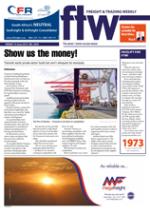Import duties are on the
rise – and likely to continue
their upward trajectory as a
protectionist defence in the
global economic gloom.
According to an article
written by Matthew Stern
of DNA Economics, import
duties are once again
emerging as a preferred
policy option.
On the local scene, he
noted, the first industry that
began to enjoy rising tariffs
was the clothing sector.
This industry, Brian
Brink, executive director
of the Textile Federation
told FTW, recently had its
protective import duties
raised from 40% to 45%.
Designed, he added, to
protect a local industry
battered by massively cutprice
imports from the likes
of China.
And, added Stern, this
trend in rising import
duties has since spread
across a much wider range
of manufactured items
(from windscreens to taps
to chickens, according to
him). Questions, he said,
have also been asked about
the agricultural concessions
made by SA in the free
trade agreement with the
European Union (EU), “and
whether these can somehow
be clawed back”.
Brink, although not a
card-carrying member of
the total protectionism
party, certainly sees a place
for import duties.
“Their removal,” he said,
“would cause havoc with
SA’s worker employment –
one of the country’s vital
needs.”
There is therefore a need
to regulate trade to prevent
a lot of hard-pressed local
industries from going into
full free-fall, he added.
And he’s not saying
that because his own
industry is sitting behind a
protectionist barrier. Import
duties on fabrics, he told
FTW, have been at 22%
since 2002.
But that’s the gross total.
There are rebate facilities so
that importers can actually
get specific types of fabrics
in completely duty-free.
“Also, take into account
all these rebates, and the
effective (net) tariff is only
9.3%.”
Brink also highlighted
just what ridiculous prices
some of these competitive
imported fabrics were
coming in at. Cut-price just
doesn’t begin to describe it,
with these fabrics so much
below cost that it beggars
belief.
“In May,” he told FTW,
“it was R2 per kilogram
on average for fabric. Now
can you believe that? You
can’t buy cotton for less that
R16/kg – and that’s just for
cotton lint (fibres – the raw
material).
“They are running
rings round the state, and
defrauding it of billions of
rand.”
But Stern – an avid antiprotectionist
– is anything
but convinced by such
arguments.
“Whereas the benefits
to specific firms from
increased tariff protection
are clear,” he said, “the
wider economic impact of
tariff decisions are often
misunderstood and easily
neglected.”
Before leaping to the
protection of an individual
applicant, he defined (and
explained in full-depth) ten
truths that should be borne
in mind by trade policy
makers.
“Tariffs are, in the end,
just another tax, and, as
far as taxes go, tariffs are
horribly regressive.
“The actual amount
of protection given by a
tariff is much higher than
it seems; they subsidise
smuggling and corruption,
and are biased against
exports.
“Tariffs do not help firms
to become internationally
competitive, are the wrong
instrument to improve
national competitiveness,
and result in a net
deadweight loss.”
His concluding two truths
also had a positive ring to
them. “Just because other
countries use them,” he said,
“does not make it right; and
most of the economy is not
protected by tariffs and does
just fine.”
There are the two sides
to the argument, the pros
and cons of trade tariffs as
a policy of choice. Which
are you – a protectionist
through-and-through, or
an ardent supporter of free
trade?
INSERT & CAPTION
Cut-price just doesn’t
begin to describe it,
with these fabrics so
much below cost that
it beggars belief.
– Brian Brink

